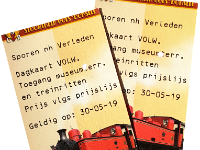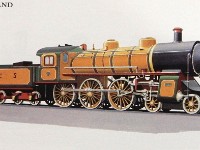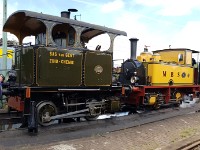 1 The Stoomtrein Goes - Borsele (Goes-Borsele Steam Train) is a heritage railway operating from Goes through Kwadendamme to the village of Hoedekenskerke, in the province of Zeeland, Netherlands. The railway's headquarters are located at Goes. From here trains operate between Goes and Baarland. On intensive service days the railway operates both steam trains and diesel railcar trains. SGB operate a fleet of seventeen locomotives - nine diesel engines, six steam engines, and two relatively unusual 1,500 volt Alstom electric engines. Additionally, three heritage diesel railcars are in service. On the day of our visit there were some visiting locomotives from other Dutch heritage railways |
 2 The SGB terrain is substantial. You can view this map on Google and zoom in or out and switch layers off. The yellow line shows the tracks the locomotives have to pass to get from the station to the coaling stage. This may be cumbersome for operations but it makes an excellent display for visitors. |
 3 In the locomotive workshop there was a demonstration track with live steam locomotives. One of the themes was this Accucraft NGG16. We spent quite some time watching and talking with the owner while he prepared the engine to run. |
 4 |
|||
 5 |
 6 |
 7 |
 8 |
|||
 9 Getting the loco on the rails is a two men job, not for the weight but mostly to be careful about not bending the joints between the unit too much and prevent tubes and other connections to go their own way. |
 10 |
 11 |
 12 The electronics for remote control |
|||
 13 And the proud owner |
 14 |
 15 |
 16 |
|||
 17 |
 18 |
 19 We thoroughly enjoyed the model but no less the company and companionship of the lads from Stoom4Fun |
 20 Outside this operable 1300 was on display. It came to this event under its own power. |
|||
 21 A 2400-class diesel. Built for the Netherlands in the 1950 it was sold to the Channel Tunnel works in the 90s. After that it rested/rusted in France and it was subsequently acquired as museum locomotive. The loco is complete but not operable. |
 22 Under repair is this Krupp from 1924. (More info (in Dutch) |
 23 A scene straight form the thirties... |
 24 Although it may not seem so, I was told that this loco is close to being returned to operation. |
|||
 25 The Machine shop. Now that was a treat. We talked a little with the local Lord and Master :-) |
 26 Loco no 3, "Bison" dating from 1928, served as shunting locomotives in the Dutch mine industry. |
 27 |
 28 |
|||
 29 Coach under construction to match the recently completed replica of the omBC class (More in Dutch |
 30 |
 31 Shunting outside with this Oersik, meaning as much as "original he-goat". Original because it was one of the earliest designs of the type, he-goat because its whistle was connected to the exhaust of the diesel internal combustion engine and consequently made a bleating sound. This was one of 50 engines built for light shunting services on large stations to replace the small steam locomotives in the 1930s. |
 32 |
|||
 33 |
 34 Left an example of a later, more powerful version. Both classes had the advantage that they were simple to operate, so staff need not be fully qualified as an engine driver. They were sturdy. Many of them operated well into the 2000s. Of the first class (right) six remain in existence, and the one pictured here is the only operational. Of the two heavier versions (52+169 built) 10 and 89 remain. |
 35 Another one from the same class |
 36 1100 class from the 1950s |
|||
 37 |
 38 |
 39 After WWII many army stock was left surplus in Europe. Among them was a large batch of USATC diesel locomotives. The Dutch railways bought 20 of them to strengthen their heavily afflicted fleet of motive power. 18 saw service the other two were used for spares. They were withdrawn and subsequently scrapped from 1958 to 1960. This locomotive (1943, Whitcomb Locomotive Works, 65-DE-19A) was acquired in 2017 from Lehigh Cement in Mason City (Iowa). It is now conserved under the USATC livery but it is scheduled to return to active service in 2020 |
 40 |
|||
 41 It was not too busy. Visitor numbers peaked a little around the departure times of the steam trains but overall it was a congenial event where you could get to whatever drew your interest. |
 42 An Orenstein & Koppel from 1921. It came to the Netherlands in 1934 to serve in the industry and went into preservation in 1971. It has been inoperable since the 90s. |
 43 |
 44 |
|||
 45 A brilliantly restored Ford |
 46 |
 47 |
 48 Well, having moved through much of the static exhibits we gradually came to see the active loco's, for which we actually came. This is a USATC S100 shunter locomotive that came to Europe to serve behind the front in Europe after the invasion. 382 were built, approximately 100 survive until today. See  49 Shunting towards the coaling stage |
 50 |
 51 The mist and drizzle made for a good "steamy" display |
 52 And then, all of a sudden, out came the sun. The mercury made a jump from 15C to 25C. |
 53 The sun made "light" (excuse the pun) work of getting a decent shot of the S100 at the water tower. |
 54 |
 55 Pretty big wheels for a shunter, almost 1400mm, fit for a mainline freight locomotive |
 56 Injector |
|||
 57 |
 58 |
 59 |
 60 |
|||
 61 |
 62 |
 63 All visiting and resident steam locomotives where a "first meet" for me, and many have been long on the list. This is Tom, a Krupp standard industrial locomotive, built in 1949. It is resident at the Tata steel mill in IJmuiden. |
 64 |
|||
 65 |
 66 |
 67 |
 68 |
|||
 69 |
 70 |
 71 |
 72 |
|||
 73 Apart from all other things a steam event is mostly a social event. |
 74 |
 75 The modest admittance fee also gave free rides all day. The S100 was to pull our train. |
 76 Preparing for the ride. Old Class '24 (yes from the 1920s) stock. |
|||
 77 |
 78 |
 79 |
 80 |
|||
 81 A quick shot of the boiler backhead before the train left. When passing the next we crossed on the other steam locomotives we were after. We quickly changed trains and got back to Goes. |
 82 ... where we found this beauty |
 83 |
 84 |
|||
 85 |
 86 |
 87 |
 88 |
|||
 89 |
 90 |
 91 |
 92 |
|||
 93 Minutes later the tram arrived, here seen in the shunt towards the water and coaling stage |
 94 |
 95 |
 96 |
|||
 97 |
 98 These two stayed together all day |
 99 |
 100 |
|||
 101 |
 102 |
 103 |
 104 |
|||
 105 |
 106 |
 107 |
 108 |
|||
 109 |
 110 |
 111 This type of locomotive was typical for the Dutch tramways. They have been here by the hundreds and only a few remain. In fact I believe this is the only operable example at this moment. The fully enclosed cab offers the advantage of being able to walk around the boiler and operate the locomotive form both side. One man operation was common. The low skirts had the intention of preventing the general public from being cut up by the moving parts. The black thing on the roof was a condenser which minimised steam exhaust in urban areas. |
 112 |
|||
 113 |
 114 |
 115 |
 116 |
|||
 117 |
 118 No 6 is owned by the MBS in Haaksbergen. The one special feature is that her livery is an approximation of the livery of the NCS, a mainline company until 1917. |
 119 Their ten express locomotives must have looked like this |
 120 Greasing up |
|||
 121 |
 122 |
 123 |
 124 |
|||
 125 |
 126 A vertical boilered locomotive from 1926 |
 127 |
 128 |
|||
 129 Somehow the locomotive makes the impression of being built in reverse, but as there is no smokebox end it is hard to tell. |
 130 |
 131 The trio together |
 132 Aha there is the water hatch! |
|||
 133 |
 134 Conditions are, not unlike Fairlies, very cramped. |
 135 |
 136 Done! |
|||
 137 Next! |
 138 |
 139 |
 140 |
|||
 141 |
 142 |
 143 And the last one! |
 144 |